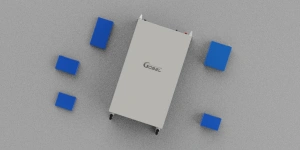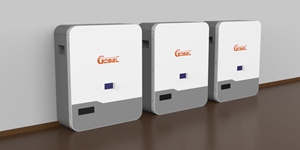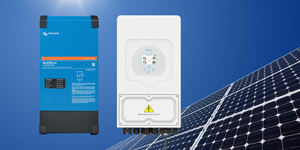HOUSEHOLD ENERGY STORAGE MARKET "BLOWOUT"
By Kelly posted 2022-07-14 11:47:20By the end of 2022, Paineng Technology's production capacity is expected to reach 7GWh, and in 2024, it will reach over 12GWh of energy storage system supply capacity.
"Household energy storage is like air conditioning in the '90s."
One meaning is that it is entering thousands of households in overseas markets like air conditioners in the 1990s; the other meaning is that the shape of household energy storage is gradually equal to the volume of a cabinet air conditioner, and the household integrated machine gradually become a trend.
Affected by the surge in global energy prices, the household energy storage market is showing an explosive trend in Europe and the United States, especially European household energy storage is the world leader.
Household energy storage has low penetration rate, strong overseas policy support, and high customer demand. In developed countries with high electricity prices such as Europe, the United States, Japan, and Australia, it has good economy, rigid demand, strong willingness to pay and price acceptability.
With the current global energy shortage, soaring electricity and gas prices overseas, and the economics of solar energy storage, under the general trend of carbon neutrality, household energy storage will become the fourth high-speed growth in the new energy industry after wind power, photovoltaics, and electric vehicles. the track.
Judging from last year's shipments, China's "first brother" of household energy storage, Paineng Technology, ranks second in the world in global shipments, second only to Tesla Powerwall, which ranks first in the global household energy storage list. This is the epitome of the popularity of household energy storage.
In 2022, Paineng Technology's performance is still outstanding, and it has gradually become the "darling" of the capital industry. Its closing price rose to 419.00 yuan on July 11.
Undoubtedly, this is a hot market that the global industry is keeping an eye on.
Global companies such as Tesla, Paineng, Sonnen, BYD, Huawei, LG Energy, GoodWe, Jinlang Technology, Hekang New Energy, and Sunwoda are accelerating their competition.
In the current situation of tight energy supply and rising raw material prices, household energy storage is still the first to break through.
The phrase "the first look at the household sector in the global energy storage market" shows the popularity of household energy storage.
Large demand in Europe and the United States, strong economic driving force
The underlying reason for the popularity of household energy storage comes from the demand side.
On the one hand, electricity prices in Europe have risen significantly, and the conflict between Russia and Ukraine has exacerbated the European energy crisis. European energy prices have exceeded 200 euros/MWh, and European natural gas prices have risen by more than 8 times since 2020.
The low cost of solar energy storage allows European and American consumers to recover their investment costs in almost 3-5 years. Since 2021, household energy storage has shown an explosive growth trend in the European and American markets with an annual growth rate of doubling.
In 2021, the 27 EU countries will add 25.9GW of photovoltaics to the grid, providing good conditions for household energy storage.
The typical usage scenario of current household energy storage is to form a household solar energy storage system in combination with household photovoltaics. According to estimates, compared with not equipped with photovoltaic and energy storage systems, the ten-year electricity cost savings of photovoltaic and energy storage equipment is 12,673.64 euros, and the investment payback period is 5 years; while only installing photovoltaic systems saves electricity costs of only 4,816.87 euros, photovoltaic + storage The energy solution is highly economical.
A typical household solar energy storage system includes photovoltaic modules, energy storage battery systems, energy storage inverters, etc. According to estimates, generally a set of optical storage system can pay back its cost as short as 3 years.
Residential energy storage has grown rapidly in Europe in recent years. According to statistics, more than 90% of the European household energy storage share is concentrated in the top five countries - Germany, Italy, the United Kingdom, Austria, and Switzerland. Among them, Germany is the largest residential energy storage market in Europe.
In general, the outbreak of the European household energy storage market mainly relies on its excellent economy.
On the other hand, the demand for household energy storage in the United States has also risen rapidly, and giants such as Tesla have further improved the economics of household energy storage. Relevant data show that the total newly installed capacity from 2021 to 2026 will reach 63.4GW/202.5GWh, of which households can reach 4.9GW/14.3GWh.
Recently, Tesla partnered with California public utility PG&E to create a new virtual power plant (VPP), offering eligible Powerwall users a $2 per kWh incentive. It is reported that 50,000 Powerwall users will be eligible for the subsidy.
Estimated based on market power demand and the number of Powerwall users, no matter where they are, they can earn $10-$60 per dispatch. The economics of household energy storage will also be further highlighted in the US market.
Companies in the home storage sector such as Paineng performed strongly and the competition accelerated
The huge space on the demand side has created the prosperity of the market side. Global companies are accelerating the race for residential energy storage.
Relevant data shows that in 2019, the top three global household energy storage product shipments were Tesla, LG Chem and Pine Energy Technology, accounting for 15%, 11% and 8.5% respectively. In 2020, this data will undergo a new round of refresh, and the top five global household energy storage product shipments will be changed to Tesla, Paine Energy, Germany's Sonnen, LG Chem, and China's Wotai Energy.
The latest statistics show that in the field of household energy storage, Tesla, with its outstanding product strength and brand effect, accounts for 15% of the global household energy storage market, followed by Paineng Technology (2.62%), accounting for 15% of the total. At 13%, the gap between them is gradually decreasing.
In Germany, where the penetration rate of household energy storage is relatively high, the brand Sonnen has the highest proportion of the household energy storage market, followed by BYD (5.63%). It can be seen that Chinese and foreign companies such as Tesla, Paineng Technology, Sonnen, BYD, and LG Energy are competing to open the acceleration mode in the global household energy storage market.
It is worth mentioning that, thanks to the high demand from overseas, the Chinese company Paineng Technology, which has been deeply involved in the overseas home storage market, has achieved outstanding results, and the pace of production expansion has also accelerated significantly. This may bring some enlightenment to other Chinese enterprises entering the market.
On June 9 this year, Paineng Technology accelerated its expansion of battery cell production. It plans to issue stocks to specific objects to raise a total of no more than 5 billion yuan, which will be used to invest in the construction of 10GWh battery cells and system assembly production lines and related supporting facilities, headquarters and industrialization base projects and supplementary working capital.
It is reported that the compound growth rate of the energy storage battery system of Paineng Technology has reached 63.40% in the past three years. According to reports, by the end of 2022, the production capacity of Paineng Technology is expected to reach 7GWh, and the supply capacity of energy storage systems will exceed 12GWh in 2024.
By virtue of product strength and channel advantages, Paine Technology has built the company's brand moat, and currently has a strong first-mover advantage.
In terms of products, Paineng Technology has the core technology of reducing battery temperature rise at the cell level, which can reduce the probability of thermal runaway. The main products have passed international IEC, EU CE, European VDE, American UL, Australian CEC, Japanese JIS, United Nations UN38.3 and other safety certifications.
In terms of system building, Paineng technology products adopt high-reliability structural design, and are equipped with high-precision, intelligent, high-safety and reliable battery management systems.
In terms of channels, PinePower has established long-term and stable cooperative relations with Segen, the largest photovoltaic system provider in the UK, Krannich, a leading provider of optical storage systems in Germany, and Energy, a leading provider of energy storage systems in Italy, with strong channel barriers.
With the high prosperity of the outdoor energy storage track, Paineng Technology has gradually become a "star" of household energy storage in the industry.

 Europe Warehouse
Europe Warehouse










